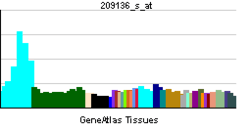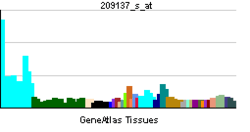USP10
Ubiquitin specific peptidase 10, also known as USP10, is an enzyme which in humans is encoded by the USP10 gene.[1]
Function
Ubiquitin is a highly conserved protein that is covalently linked to other proteins to regulate their function and degradation. This gene encodes a member of the ubiquitin-specific protease family of cysteine proteases. The enzyme specifically cleaves ubiquitin from ubiquitin-conjugated protein substrates. The protein is found in the nucleus and cytoplasm. It functions as a co-factor of the DNA-bound androgen receptor complex, and is inhibited by a protein in the Ras-GTPase pathway. The human genome contains several pseudogenes similar to this gene.[1]
Interactions
USP10 has been shown to interact with G3BP1.[2]
References
- ↑ 1.0 1.1 "Entrez Gene: USP10 ubiquitin specific peptidase 10".
- ↑ Soncini C, Berdo I, Draetta G (June 2001). "Ras-GAP SH3 domain binding protein (G3BP) is a modulator of USP10, a novel human ubiquitin specific protease". Oncogene 20 (29): 3869–79. doi:10.1038/sj.onc.1204553. PMID 11439350.
Further reading
- D'Andrea A, Pellman D (1999). "Deubiquitinating enzymes: a new class of biological regulators.". Crit. Rev. Biochem. Mol. Biol. 33 (5): 337–52. doi:10.1080/10409239891204251. PMID 9827704.
- Puente XS, Sánchez LM, Overall CM, López-Otín C (2003). "Human and mouse proteases: a comparative genomic approach.". Nat. Rev. Genet. 4 (7): 544–58. doi:10.1038/nrg1111. PMID 12838346. Vancouver style error (help)
- Nagase T, Seki N, Ishikawa K, Tanaka A, Nomura N (1996). "Prediction of the coding sequences of unidentified human genes. V. The coding sequences of 40 new genes (KIAA0161-KIAA0200) deduced by analysis of cDNA clones from human cell line KG-1.". DNA Res. 3 (1): 17–24. doi:10.1093/dnares/3.1.17. PMID 8724849.
- Soncini C, Berdo I, Draetta G (2001). "Ras-GAP SH3 domain binding protein (G3BP) is a modulator of USP10, a novel human ubiquitin specific protease.". Oncogene 20 (29): 3869–79. doi:10.1038/sj.onc.1204553. PMID 11439350.
- Fortna A, Kim Y, MacLaren E, Marshall K, Hahn G, Meltesen L et al. (2006). "Lineage-specific gene duplication and loss in human and great ape evolution.". PLoS Biol. 2 (7): E207. doi:10.1371/journal.pbio.0020207. PMC 449870. PMID 15252450.
- Beausoleil SA, Jedrychowski M, Schwartz D, Elias JE, Villén J, Li J et al. (2004). "Large-scale characterization of HeLa cell nuclear phosphoproteins.". Proc. Natl. Acad. Sci. U.S.A. 101 (33): 12130–5. doi:10.1073/pnas.0404720101. PMC 514446. PMID 15302935. Vancouver style error (help)
- Rual JF, Venkatesan K, Hao T, Hirozane-Kishikawa T, Dricot A, Li N et al. (2005). "Towards a proteome-scale map of the human protein-protein interaction network.". Nature 437 (7062): 1173–8. doi:10.1038/nature04209. PMID 16189514.
- Kimura K, Wakamatsu A, Suzuki Y, Ota T, Nishikawa T, Yamashita R et al. (2006). "Diversification of transcriptional modulation: large-scale identification and characterization of putative alternative promoters of human genes.". Genome Res. 16 (1): 55–65. doi:10.1101/gr.4039406. PMC 1356129. PMID 16344560.
- Faus H, Meyer HA, Huber M, Bahr I, Haendler B (2006). "The ubiquitin-specific protease USP10 modulates androgen receptor function.". Mol. Cell. Endocrinol. 245 (1-2): 138–46. doi:10.1016/j.mce.2005.11.011. PMID 16368182.
- Grunda JM, Nabors LB, Palmer CA, Chhieng DC, Steg A, Mikkelsen T et al. (2007). "Increased expression of thymidylate synthetase (TS), ubiquitin specific protease 10 (USP10) and survivin is associated with poor survival in glioblastoma multiforme (GBM).". J. Neurooncol. 80 (3): 261–74. doi:10.1007/s11060-006-9191-4. PMID 16773218.
- Beausoleil SA, Villén J, Gerber SA, Rush J, Gygi SP (2006). "A probability-based approach for high-throughput protein phosphorylation analysis and site localization.". Nat. Biotechnol. 24 (10): 1285–92. doi:10.1038/nbt1240. PMID 16964243. Vancouver style error (help)
- Deng S, Zhou H, Xiong R, Lu Y, Yan D, Xing T et al. (2007). "Over-expression of genes and proteins of ubiquitin specific peptidases (USPs) and proteasome subunits (PSs) in breast cancer tissue observed by the methods of RFDD-PCR and proteomics.". Breast Cancer Res. Treat. 104 (1): 21–30. doi:10.1007/s10549-006-9393-7. PMID 17004105.
- Olsen JV, Blagoev B, Gnad F, Macek B, Kumar C, Mortensen P et al. (2006). "Global, in vivo, and site-specific phosphorylation dynamics in signaling networks.". Cell 127 (3): 635–48. doi:10.1016/j.cell.2006.09.026. PMID 17081983.

